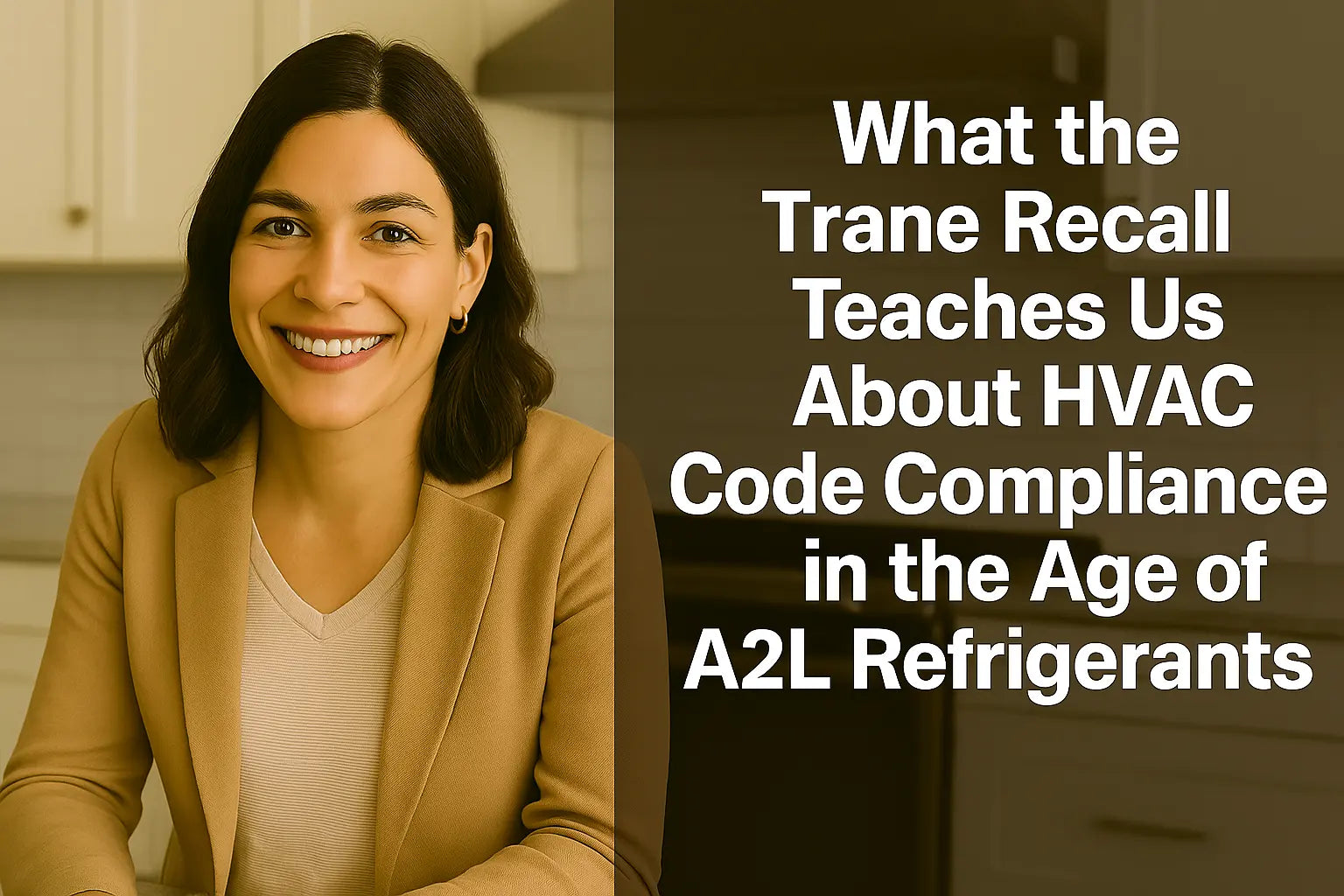Hey HVAC heroes—it’s your girl, Savvy Mavi, back again!
So by now you’ve probably heard all about the Trane recall, right? If not, here’s the tea: over 60,000 gas-electric packaged HVAC units were recalled due to improper wiring that could cause fires. 😳
Yeah... not ideal.
But beneath the headlines, something even bigger was exposed: a serious lack of preparedness for the HVAC industry’s next chapter—especially when it comes to refrigerants like R-32, A2L safety classifications, and evolving building codes.
So today, we’re not just talking product recalls—we’re talking compliance, safety, and what your HVAC system needs to be legally AND practically future-ready. 🧠💪
Let’s get into it.
First, What the Heck Is A2L? 🤷
A2L is a refrigerant safety classification developed by ASHRAE. Here's the breakdown:
-
"A" = Low toxicity
-
"2L" = Mildly flammable
That’s right—R-32, one of the newest, most efficient refrigerants available, falls into this category. It's not explosive, but it does require extra precautions during installation. And because of this, building codes and HVAC safety standards are shifting fast to accommodate the safe use of A2L refrigerants.
Thanks to updated guidance from ASHRAE and the International Code Council (ICC), R-32 systems can now be safely and legally installed in U.S. homes—but only if the units and installers follow specific requirements. 🧯
How Trane’s Recall Connects to Code Compliance ⚠️
Let’s be honest—the Trane recall wasn’t just about a wiring defect. It was about what happens when HVAC systems are rushed to market without enough planning around code compliance, material safety, or long-term risk management.
According to the CPSC’s official notice, the recalled units had heat exchangers wired incorrectly, which led to overheating and fire hazards. 🔥
Now, imagine adding a mildly flammable refrigerant like R-32 into the mix—without the right wiring, sensors, airflow design, or pressure relief standards. 💀 That’s a recipe for disaster.
This is why code compliance matters.
And this is exactly why manufacturers and homeowners are moving toward R-32 split systems that are built specifically to meet A2L refrigerant codes.
What’s New in the 2025 HVAC Codes 🔍
Let’s break it down. If your HVAC system is older than a few years, it probably doesn’t meet all of these new and upcoming requirements:
✅ UL 60335-2-40 Certification for equipment using flammable refrigerants
✅ Proper leak detection and ventilation to prevent ignition risks
✅ Maximum refrigerant charge limits for residential installations
✅ Contractor certification to handle A2Ls
✅ Labeling and access panels for maintenance safety
Systems using R-32 refrigerant already meet these standards—but only when built by manufacturers who design for them intentionally.
The R-32 split systems sold by The Furnace Outlet are built from the ground up to check every one of those boxes. They’re not retrofits or shortcuts—they’re the real deal.
What Homeowners Need to Know (Without Falling Asleep 😴)
If you’re not an HVAC contractor, the idea of refrigerant codes and safety specs might make your eyes glaze over. So here’s what actually matters for you, the homeowner:
🔥 R-32 is safe—but only in the right system
🧯 Not all brands build their systems to meet A2L codes
📜 Most older packaged units don’t meet 2025-ready safety guidelines
🔧 Contractor training is critical—ask if they’re A2L-certified
🏡 Split systems are safer than rooftop packaged units
What does that mean in plain terms? You shouldn’t settle for outdated systems with questionable refrigerants or risky wiring. And you shouldn’t pay top dollar for something that’s already headed for noncompliance.
Instead, choose a system designed for the future—and backed by people who actually understand what safe, code-compliant installation looks like.
But Isn’t R-32 Flammable? Let’s Talk Facts 💥
Look, I know what you’re thinking: “Mavi, you keep saying it’s ‘mildly flammable’—that doesn’t exactly put me at ease.”
Fair! But here’s what matters:
✅ R-32 doesn’t ignite easily—it needs a perfect combo of heat, pressure, and oxygen to spark.
✅ No open flames or ignition sources should ever be near your refrigerant lines anyway.
✅ Modern R-32 systems have built-in safeguards: leak sensors, ventilation design, proper charge sizing, etc.
✅ It’s less flammable than propane, which many of us use every day for heating and cooking.
How to Upgrade with Confidence 🔁💡
If you’re still running a packaged unit—especially one built before 2023—you’re probably already behind on code compliance. The good news? Upgrading is easier than ever.
Here’s how to do it:
-
Browse R-32 + gas furnace combos at The Furnace Outlet
-
Talk to a contractor who’s certified for A2L refrigerants
-
Make sure your install meets UL 60335-2-40 standards
-
Apply for rebates or tax credits under the Inflation Reduction Act
-
Rest easy knowing your system is safe, smart, and future-proof
Final Word from Savvy Mavi 💁🛡️
Let’s be clear: the Trane recall was scary. But for those of us paying attention? It was a wake-up call. A signal that it’s time to leave behind old systems and step into an HVAC future that’s smarter, safer, and totally Savvy.
The systems you’ll find at The Furnace Outlet are already designed to meet A2L refrigerant codes and give you peace of mind for years to come.
Want to know more about the Trane recall and how it affects your current systems? Visit my guide right here!
You don’t have to wait for a disaster—or a government recall—to make a better choice. Do it now. Because your comfort shouldn’t come with a side of risk.
Stay safe, stay compliant, and stay savvy 💋
– Your Savvy HVAC Girl, Mavi







